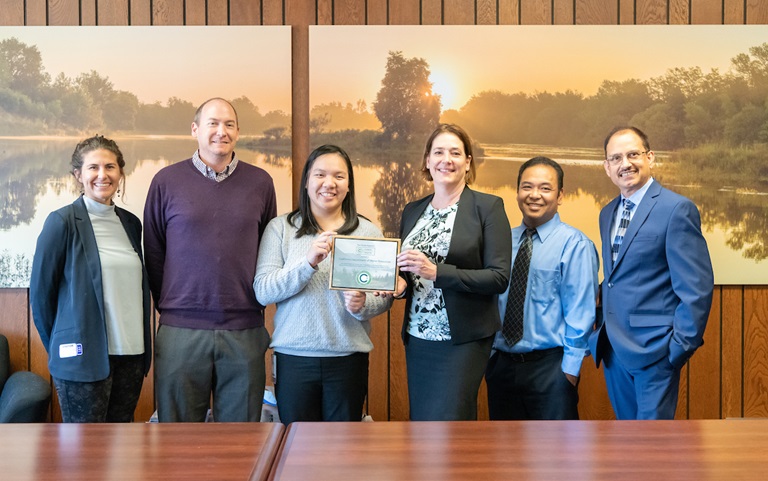DWR Recognized for Leadership in Greenhouse Gas Reduction
The Climate Registry presents DWR with Climate Registered All Star status in recognition of its leadership in reducing greenhouse gas emissions. (L-R) Chelsea Hasenauer with The Climate Registry, Ryan Radford with CalEPA, DWR’s Charmaine Duong, DWR Director Karla Nemeth, DWR's Gerold Mateo, and DWR's Ram Verm. DWR/2019
As an energy consumer and producer, the Department of Water Resources (DWR) is actively implementing projects and strategies to utilize renewable energy and reduce its carbon footprint.
In light of these efforts, The Climate Registry awarded DWR with the Climate Registered All Star certification for its continued leadership and commitment to reducing greenhouse gas (GHG) emissions, a significant contributor to climate change.
‘All Star certification’ - part of a newly launched Climate Registered program established by The Climate Registry – is the highest level achievable and recognizes DWR’s complete reporting, accuracy, transparency, goal setting, emission reduction goal achievement, generation and purchase of carbon free energy, and expertise in GHG emission and compliance management.
“This exemplary achievement is the result of DWR’s hard work and commitment toward reducing impacts of climate change,” said Ram Verma, chief of DWR’s Market Instruments and Greenhouse Gas Compliance Branch.
The Climate Registry is a non-profit that assists organizations throughout North America in measuring, reporting, and verifying GHG emissions resulting from their operations so that they can manage and reduce emissions.
DWR has reported its GHG emissions to the Climate Registry since 2010, and has taken progressive steps to reduce its contribution to GHG emissions by investing in high-efficiency energy supplies, increasing procurement of renewable energy for operations, improving energy efficiency in pumping and generating facilities, and building renewable energy projects on State Water Project (SWP) lands.
Since 2013, DWR has eliminated coal as a source of electricity for the SWP and increased the use of renewables like solar and hydropower. In 2016, DWR completed construction on the Pearblossom Solar Facility, which provides solar energy and is located adjacent to the SWP Pearblossom Pumping Plant. The department also reduced energy consumption in its buildings and facilities by participating in SMUD’s Commercial Greenergy Program which provides power made from renewable sources.
“Your organization is leading the way toward a more sustainable future. We look forward to supporting your sustainability leadership in years to come. Together, we can make global warming history,” Amy Holm, executive director with The Climate Registry wrote in a letter to DWR.
DWR also has a comprehensive plan that ensures the SWP power portfolio meets or exceeds aggressive GHG reduction goals. DWR adopted a Greenhouse Gas Emissions Reduction Plan in 2012 with the goal to reduce its GHG emissions by 50 percent below 1990 levels by 2020, a target that the department met five years ahead of schedule in 2015.
Visit our clean energy webpage for more information on DWR’s renewable energy initiatives.
